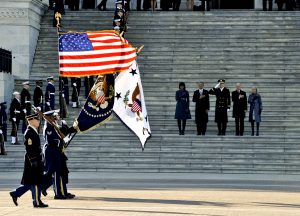 Every day I see new photos being used in all forms of media. However, when is the last time that you stopped to actually look at what’s going on in those photographs?
Every day I see new photos being used in all forms of media. However, when is the last time that you stopped to actually look at what’s going on in those photographs?
Photography is more than just taking a photo of a random occurrence. It’s about telling a story. It’s an art form. More than just a photo, photography is a piece of history forever captured in that frame. Photos from places like Afghanistan, Iraq and many other less-fortunate areas are a good example of this. They tell you a story by simply looking at them. When you see the kids peeking out from behind their parents’ legs or that older gentleman with so many lines in his face, this makes you wonder what they’ve seen in their time on Earth. Things like this can’t be described in words without losing something in the translation.
When photos accompany a written piece, they take it to the next level. For example, think of how photos of Mount St. Helens erupting made the story real for a reader. Suppose you pick up a paper and read that tons of hot ash have spilled from the mouth of this volcano. This, my friend, is where the power of a photo comes into play. Events like these simply can’t be described in words alone and have the same effect. Without those intriguing photos of the flowing red hot lava to accompany the article, you would miss a vital sense only provided by the visual effect.
In business, you want to make sure you ‘wow’ your customers with your product. When you put out written pieces about your company, they should include photographs that complement the story. It is especially important to provide photos if you plan on submitting anything to media outlets. They cannot only put them with the written pieces, but, if they are of high quality, the imagery can be used as a standalone to fill space or post on social media outlets.
To produce a high-quality photo that will grab the attention of your customers and media alike, there are simple things you can do to take your photographs to the next level. Here are two basic photography rules to help achieve this goal.
First think of your photo as a giant tic-tac-toe board. In this case, I’m using a photo of a tower in Afghanistan. By aligning the tower on my left vertical line and having the ladder come down the right side (into the photo) it draws people’s eyes into the beautiful sunset and the rest of the photograph. Had I aligned it on the right side it may still be a good photograph, but it wouldn’t have been as strong.
For another example using people, take a look at this photograph below from the presidential inauguration this past January. By aligning the flags on the left side and having them walk into the photograph, your eye naturally follows their path. Had they been on the right side, your eye would go straight to them then off to the next photo because our eyes naturally want to follow the flow.
 You can do the same with your photographs. By putting your subject (person, place or thing) either along one of the vertical or horizontal lines it will help take it to the next level. The big thing to remember is like the ladder in the tower photo, if anything is coming off your subject you typically want it on the inside of the photo so that it will lead your viewers’ eyes into the photo and not off it.
You can do the same with your photographs. By putting your subject (person, place or thing) either along one of the vertical or horizontal lines it will help take it to the next level. The big thing to remember is like the ladder in the tower photo, if anything is coming off your subject you typically want it on the inside of the photo so that it will lead your viewers’ eyes into the photo and not off it.
Angles
The angle of the photograph also plays a part of how the viewer receives your photo.
If you want your subject to appear strong and in power, then you should shoot from a low angle and up at your subject. This is why you will typically see photos of CEOs, products like cars, and even things in nature like the trees in my example photo to the right shot from a low angle. Because by doing this it makes them appear larger, in charge and powerful.
 To reverse this, shooting from up high and down at your subject can make them seem smaller or not as important.
To reverse this, shooting from up high and down at your subject can make them seem smaller or not as important.
Simply put, you shouldn’t be using just any old photograph. The photo needs to be properly captured and aesthetically pleasing to the eye. Quality photographs add another dimension to your work and increase your chances of being seen.
A photograph is more than just a picture; it’s a piece of history and a piece of art. A photograph helps you put a face to the name you’re reading about, or helps you visualize what you’re reading about so that it’s almost as if you were there.
This guest post is by Wesley Farnsworth, a photojournalist with the U.S. Air Force and currently stationed in Virginia. During his tenure as a photojournalist, he has taken photographs and written pieces on the activity in Afghanistan, was chosen to document the 57th Presidential Inauguration of Barrack Obama, and has captured many other historical events. In his free time, Wesley also owns and operates ADMIT Photography, a portrait, wedding and special event studio, dedicated to capturing the details of life’s most precious moments.
Photo Credit: Wesley Farnsworth






